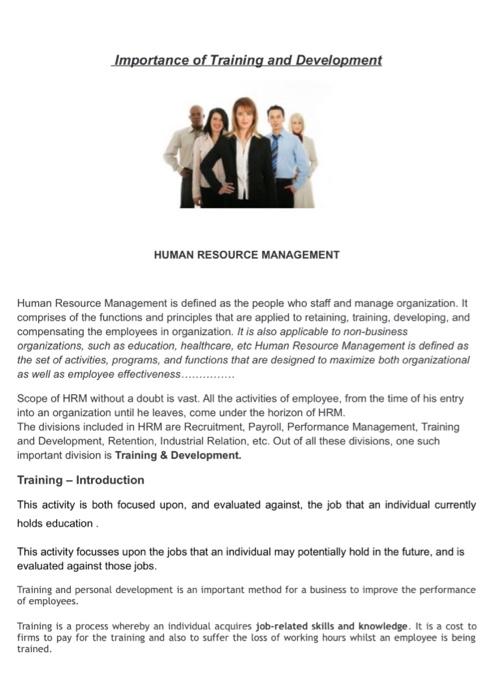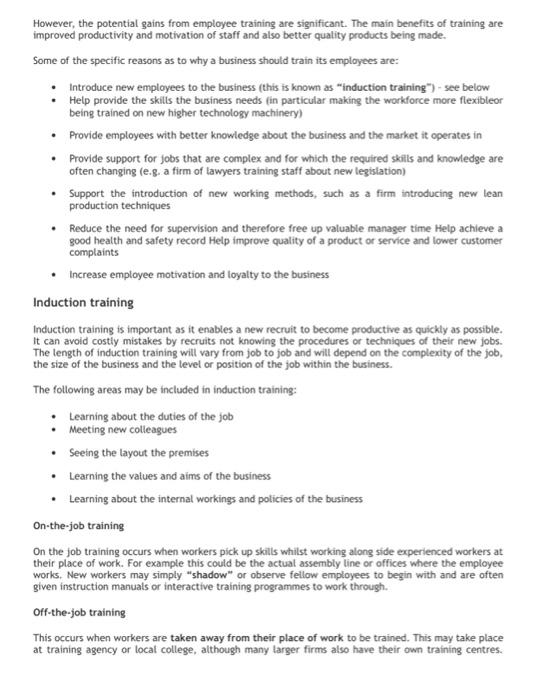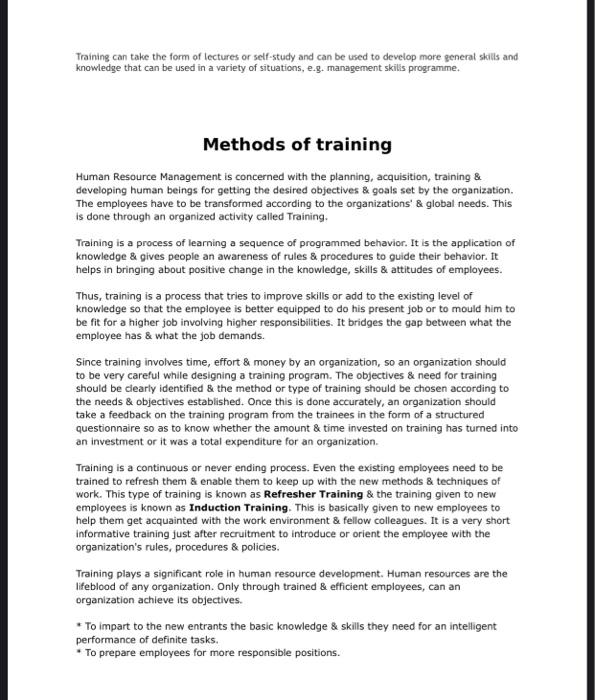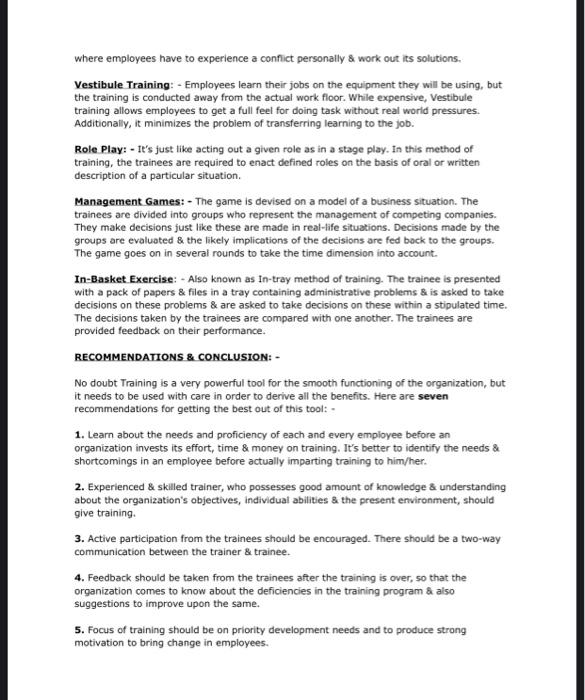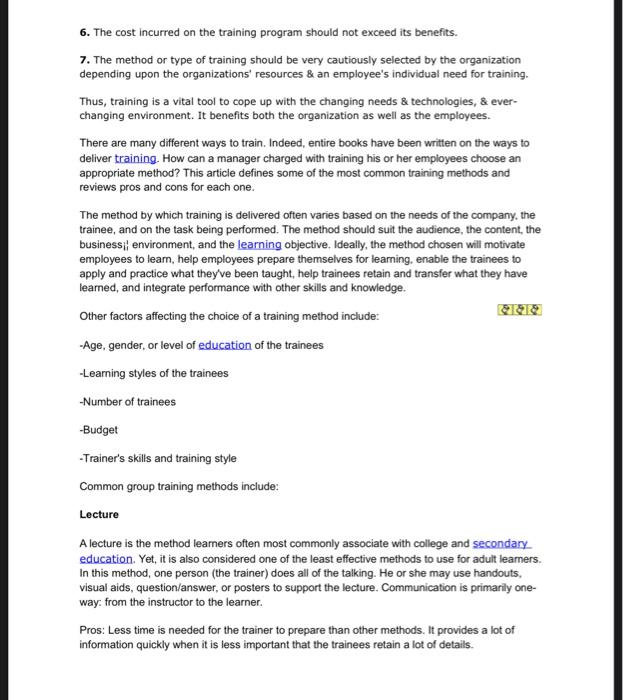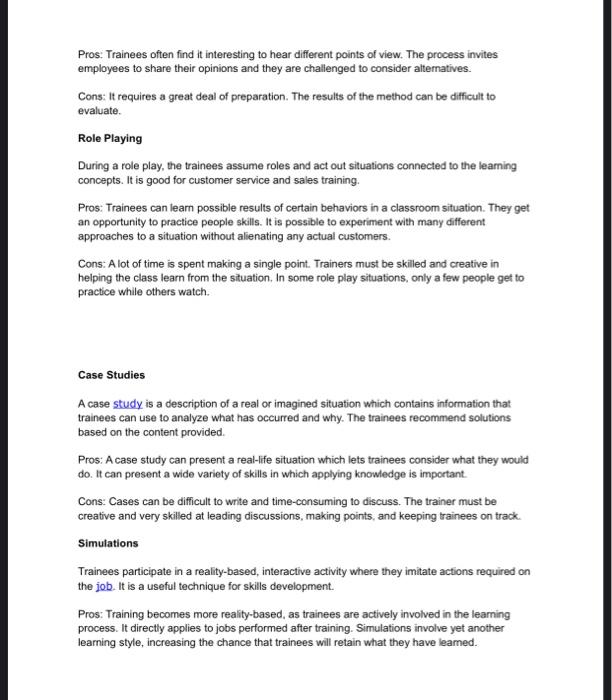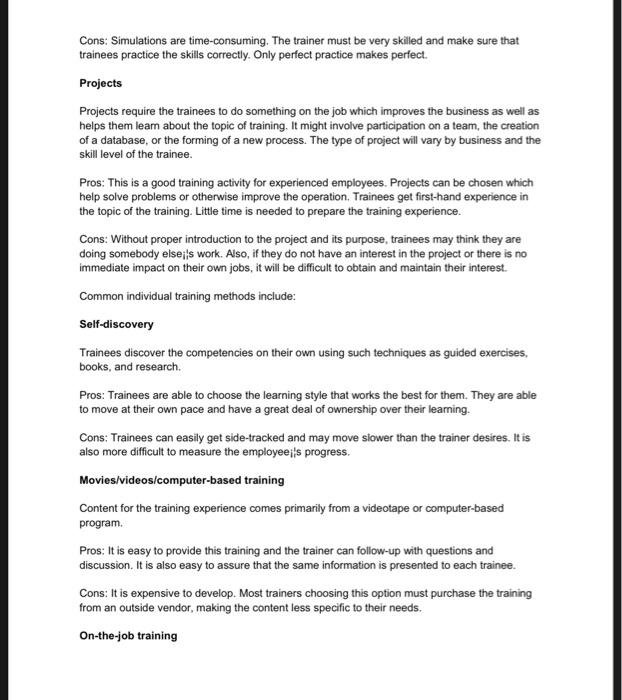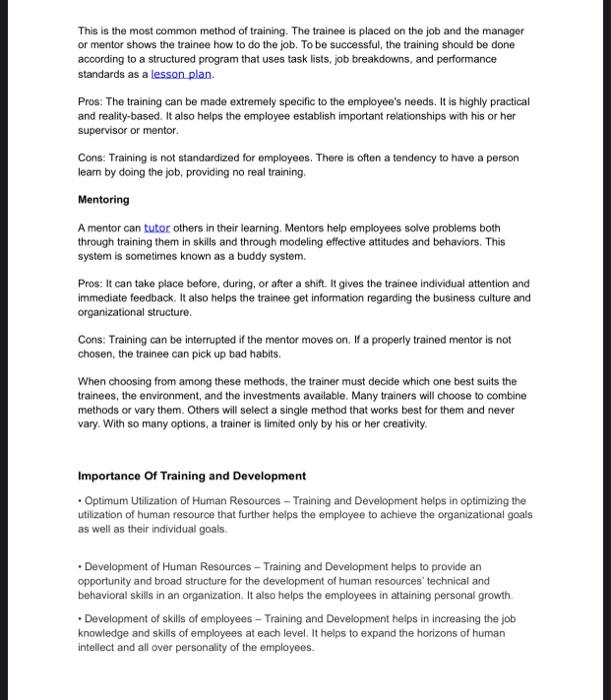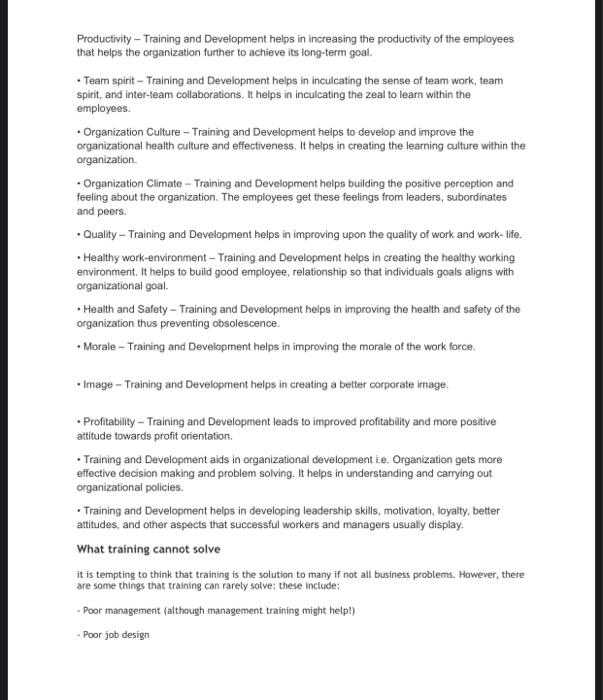Describe the role HRM has when it comes to developing and executing the following:
o job descriptions, recruiting, interviewing, candidate selection, exit interviews, and training and development
Discuss the benefits training and development, at all levels, have on the overall success of an organization.
Importance of Training and Development HUMAN RESOURCE MANAGEMENT Human Resource Management is defined as the people who staff and manage organization. It comprises of the functions and principles that are applied to retaining, training. developing, and compensating the employees in organization. It is also applicable to non-business organizations, such as education, healthcare, etc Human Resource Management is defined as the set of activities, programs, and functions that are designed to maximize both organizational as well as employee effectiveness................ Scope of HRM without a doubt is vast. All the activities of employee, from the time of his entry into an organization until he leaves, come under the horizon of HRM. The divisions included in HRM are Recruitment, Payroll, Performance Management, Training and Development, Retention, Industrial Relation, etc. Out of all these divisions, one such important division is Training \& Development. Training - Introduction This activity is both focused upon, and evaluated against, the job that an individual currently holds education. This activity focusses upon the jobs that an individual may potentially hold in the future, and is evaluated against those jobs. Training and personal development is an important method for a business to improve the performance of employees. However, the potential gains from employee training are significant. The main benefits of training are improved productivity and motivation of staff and also better quality products being made. Some of the specific reasons as to why a business should train its employees are: - Introduce new employees to the business (this is known as "induction training" ") see below - Help provide the skills the business needs (in particular making the workforce more flexibleor being trained on new higher technology machinery) - Provide employees with better knowledge about the business and the market it operates in - Provide support for jobs that are complex and for which the required skills and knowledge are often changing (e.g. a firm of lawyers training staff about new legislation) - Support the introduction of new working methods, such as a firm introducing new lean production techniques - Reduce the need for supervision and therefore free up valuable manager time Help achieve a good health and safety record Help improve quality of a product or service and lower customer complaints - Increase employee motivation and loyalty to the business Induction training Induction training is important as it enables a new recruit to become productive as quickly as possible. It can avoid costly mistakes by recruits not knowing the procedures or techniques of their new jobs. The length of induction training will vary from job to job and will depend on the complexity of the job, the size of the business and the level or position of the job within the business. The following areas may be included in induction training: - Learning about the duties of the job - Meeting new colleagues - Seeing the layout the premises - Learning the vatues and aims of the business - Learning about the internal workings and policies of the business On-the-job training On the job training occurs when workers pick up skitls whilst working along side experienced workers at their place of work. For example this could be the actual assembly line or offices where the employee works. New workers may simply "shadow" or observe fellow employees to begin with and are often given instruction manuals or interactive training programmes to work through. Off-the-job training This occurs when workers are taken away from their place of work to be trained. This may take place at training agency or local college, although many larger firms also have their own training centres. Training can take the form of lectures or self-study and can be used to develop more general skills and knowledge that can be used in a variety of situations, e.g. management skilis programme. Methods of training Human Resource Management is concerned with the planning, acquisition, training \& developing human beings for getting the desired objectives \& goals set by the organization. The employees have to be transformed according to the organizations' \& global needs. This is done through an organized activity called Training. Training is a process of learning a sequence of programmed behavior. It is the application of knowledge \& gives people an awareness of rules \& procedures to guide their behavior. It helps in bringing about positive change in the knowledge, skills \& attitudes of employees. Thus, training is a process that tries to improve skills or add to the existing level of knowledge so that the employee is better equipped to do his present job or to mould him to be fit for a higher job involving higher responsibilities. It bridges the gap between what the employee has \& what the job demands. Since training involves time, effort & money by an organization, so an organization should to be very careful while designing a training program. The objectives \& need for training should be clearly identified \& the method or type of training should be chosen according to the needs \& objectives established. Once this is done accurately, an organization should take a feedback on the training program from the trainees in the form of a structured questionnaire so as to know whether the amount \& time invested on training has turned into an investment or it was a total expenditure for an organization. Training is a continuous or never ending process. Even the existing employees need to be trained to refresh them \& enable them to keep up with the new methods & techniques of work. This type of training is known as Refresher Training \& the training given to new employees is known as Induction Training. This is basically given to new employees to help them get acquainted with the work environment \& fellow colleagues. It is a very short informative training just after recruitment to introduce or orient the employee with the organization's rules, procedures \& policies. Training plays a significant role in human resource development. Human resources are the lifeblood of any organization. Only through trained \& efficient employees, can an organization achieve its objectives. * To impart to the new entrants the basic knowledge \& skills they need for an intelligent performance of definite tasks. * To prepare employees for more responsible positions. * To bring about change in attitudes of employees in all directions. * To reduce supervision time, reduce wastage 8 produce quality products. * To reduce defects & minimize accident rate. * To absorb new skills 8 technology. * Helpful for the growth \& improvement of employee's skills \& knowledge. METHODS OF TRAINING: - The most widely used methods of training used by organizations are classified into two categories: On-the-Job Training \& Off-the-Job Training. ON-THE-JOB TRAINING is given at the work place by superior in relatively short period of time. This type of training is cheaper \& less time-consuming. This training can be imparted by basically four methods: - Coaching is learning by doing. In this, the superior guides his sub-ordinates 8 gives him/her job instructions. The superior points out the mistakes 8 gives suggestions for improvement. Job Rotation: - In this method, the trainees move from one job to another, so that he/she should be able to perform all types of jobs. E.g. In banking industry, employees are trained for both back-end 8 front-end jobs. In case of emergency, (absenteeism or resignation), any employee would be able to perform any type of job. OFF THE JOB TRAINING: - is given outside the actual work place. Lectures/Conferences: This approach is well adapted to convey specific information, rules, procedures or methods. This method is useful, where the information is to be shared among a large number of trainees. The cost per trainee is low in this method. Films: - can provide information 8 explicitly demonstrate skills that are not easily presented by other techniques. Motion pictures are often used in conjunction with Conference, discussions to clarify & amplify those points that the film emphasized. Simulation Exercise: - Any training activity that explicitly places the trainee in an artificial environment that closely mirrors actual working conditions can be considered a Simulation. Simulation activities include case experiences, experiential exercises, vestibule training. management games 8 role-play. Cases: - present an in depth description of a particular problem an employee might encounter on the job. The employee attempts to find and analyze the problem, evaluate alternative courses of action & decide what course of action would be most satisfactory. Experiential Exercises: - are usually short, structured learning experiences where individuals learn by doing. For instance, rather than talking about inter-personal conflicts 8 . how to deal with them, an experiential exercise could be used to create a conflict situation where employees have to experience a confict personally \& work out its solutions. Vestibule Training: - Employees learn their jobs on the equipment they will be using, but the training is conducted away from the actual work floor. While expensive, Vestibule training allows employees to get a full feel for doing task without real world pressures. Additionally, it minimizes the probiem of transferring learning to the job. Role Play: - It's just like acting out a given role as in a stage play. In this method of training, the trainees are required to enact defined roles on the basis of oral or written description of a particular situation. Management Games: - The game is devised on a model of a business situation. The trainees are divided into groups who represent the management of competing companies. They make decisions just like these are made in real-life situations. Decisions made by the groups are evaluated 8 the likely implications of the decisions are fed back to the groups. The game goes on in several rounds to take the time dimension into account. In-Basket Exercise: - Also known as In-tray method of training. The trainee is presented with a pack of papers 8 files in a tray containing administrative problems 8 is asked to take decisions on these problems 8 are asked to take decisions on these within a stipulated time. The decisions taken by the trainees are compared with one another. The trainees are provided feedback on their performance. RECOMMENDATIONS \& CONCLUSION: - No doubt Training is a very powerful tool for the smooth functioning of the organization, but it needs to be used with care in order to derive all the benefits. Here are seven recommendations for getting the best out of this tool: - 1. Learn about the needs and proficiency of each and every employee before an organization invests its effort, time & money on training. It's better to identify the needs 8 . shortcomings in an employee before actually imparting training to him/her. 2. Experienced & skilled trainer, who possesses good amount of knowledge 8 understanding about the organization's objectives, individual abilities 8 the present environment, should give training. 3. Active participation from the trainees should be encouraged. There should be a two-way communication between the trainer 8 trainee. 4. Feedback should be taken from the trainees after the training is over, so that the organization comes to know about the deficiencies in the training program 8 also suggestions to improve upon the same. 5. Focus of training should be on priority development needs and to produce strong motivation to bring change in employees. 6. The cost incurred on the training program should not exceed its benefits. 7. The method or type of training should be very cautiously selected by the organization depending upon the organizations' resources \& an employee's individual need for training. Thus, training is a vital tool to cope up with the changing needs \& technologies, \& everchanging environment. It benefits both the organization as well as the employees. There are many different ways to train. Indeed, entire books have been written on the ways to deliver training. How can a manager charged with training his or her employees choose an appropriate method? This article defines some of the most common training methods and reviews pros and cons for each one. The method by which training is delivered often varies based on the needs of the company, the trainee, and on the task being performed. The method should suit the audience, the content, the businessil environment, and the learning objective. Ideally, the method chosen will motivate employees to learn, help employees prepare themselves for learning, enable the trainees to apply and practice what they've been taught, help trainees retain and transfer what they have leamed, and integrate performance with other skills and knowledge. Other factors affecting the choice of a training method include: -Age, gender, or level of education of the trainees -Learning styles of the trainees - Number of trainees -Budget -Trainer's skills and training style Common group training methods include: Lecture A lecture is the method leamers often most commonly associate with college and secondary education. Yet, it is also considered one of the least effective methods to use for adult leamers. In this method, one person (the trainer) does all of the talking. He or she may use handouts, visual aids, question/answer, or posters to support the lecture. Communication is primarily oneway: from the instructor to the learner. Pros: Less time is needed for the trainer to prepare than other methods. It provides a lot of information quickly when it is less important that the trainees retain a lot of details. Cons: Does not actively involve trainees in training process. The trainees forget much information if it is presented only orally. Demonstration Demonstration is very effective for basic skills training. The trainer shows trainees how to do something. The trainer may provide an opportunity for trainees to perform the task being demonstrated. Pros: This method emphasizes the trainee involvement. It engages several senses: seeing. hearing, feeling, touching. Cons: It requires a great deal of trainer preparation and planning. There also needs to be an adequate space for the training to take place. If the trainer is not skilled in the task being taught, poor work habits can be learned by the trainee. Seminar Seminars often combine several group methods: lectures, discussions, conferences, demonstrations. Pros: Group members are involved in the training. The trainer can use many group methods as part of the seminar activity. Cons: Planning is time-consuming. The trainer must have skill in conducting a seminar. More time is needed to conduct a seminar than is needed for many other methods. Conference The conference training method is a good problem-solving approach. A group considers a specific problem or issue and they work to reach agreement on statements or solutions. Pros: There is a lot of trainee participation. The trainees build consensus and the trainer can use several methods (lecture, panel, and seminar) to keep sessions interesting. Cons: It can be difficult to control a group. Opinions generated at the conference may differ from the manageri's ideas, causing conflict. Panel A panel provides several points of view on a topic to seek alternatives to a situation. Panel members may have differing views but they must also have objective concerns for the purpose of the training. This is an excellent method for using outside resource people. Pros: Trainees often find it interesting to hear different points of view. The process invites employees to share their opinions and they are challenged to consider alternatives. Cons: It requires a great deal of preparation. The results of the method can be difficult to evaluate. Role Playing During a role play, the trainees assume roles and act out situations connected to the learning concepts. It is good for customer service and sales training. Pros: Trainees can learn possible results of certain behaviors in a classroom situation. They get an opportunity to practice people skills. It is possible to experiment with many different approaches to a situation without alienating any actual customers. Cons: A lot of time is spent making a single point. Trainers must be skilled and creative in helping the class learn from the situation. In some role play situations, only a few people get to practice while others watch. Case Studies A case study is a description of a real or imagined situation which contains information that trainees can use to analyze what has occurred and why. The trainees recommend solutions based on the content provided. Pros: A case study can present a real-life situation which lets trainees consider what they would do. It can present a wide variety of skills in which applying knowledge is important. Cons: Cases can be difficult to write and time-consuming to discuss. The trainer must be creative and very skilled at leading discussions, making points, and keeping trainees on track. Simulations Trainees participate in a reality-based, interactive activity where they imitate actions required on the job. It is a useful technique for skills development. Pros: Training becomes more reality-based, as trainees are actively involved in the learning process. It directly applies to jobs performed after training. Simulations involve yet another learning style, increasing the chance that trainees will retain what they have leamed. Cons: Simulations are time-consuming. The trainer must be very skilled and make sure that trainees practice the skills correctly. Only perfect practice makes perfect. Projects Projects require the trainees to do something on the job which improves the business as well as helps them leam about the topic of training. It might involve participation on a team, the creation of a database, or the forming of a new process. The type of project will vary by business and the skill level of the trainee. Pros: This is a good training activity for experienced employees. Projects can be chosen which help solve problems or otherwise improve the operation. Trainees get first-hand experience in the topic of the training. Little time is needed to prepare the training experience. Cons: Without proper introduction to the project and its purpose, trainees may think they are doing somebody elseits work. Also, if they do not have an interest in the project or there is no immediate impact on their own jobs, it will be difficult to obtain and maintain their interest. Common individual training methods include: Self-discovery Trainees discover the competencies on their own using such techniques as guided exercises, books, and research. Pros: Trainees are able to choose the learning style that works the best for them. They are able to move at their own pace and have a great deal of ownership over their leaming. Cons: Trainees can easily get side-tracked and may move slower than the trainer desires. It is also more difficult to measure the employeeits progress. Movies/videos/computer-based training Content for the training experience comes primarily from a videotape or computer-based program. Pros: It is easy to provide this training and the trainer can follow-up with questions and discussion. It is also easy to assure that the same information is presented to each trainee. Cons: It is expensive to develop. Most trainers choosing this option must purchase the training from an outside vendor, making the content less specific to their needs. On-the-job training Pros: The training can be made extremely specific to the employee's needs. It is highly practical and reality-based. It also helps the employee establish important relationships with his or her supervisor or mentor. Cons: Training is not standardized for employees. There is often a tendency to have a person learn by doing the job, providing no real training. Mentoring A mentor can tutor, others in their learning. Mentors help employees solve problems both through training them in skills and through modeling effective attitudes and behaviors. This system is sometimes known as a buddy system. Pros: It can take place before, during, or after a shift. It gives the trainee individual attention and immediate feedback. It also helps the trainee get information regarding the business culture and organizational structure. Cons: Training can be interrupted if the mentor moves on. If a properly trained mentor is not chosen, the trainee can pick up bad habits. When choosing from among these methods, the trainer must decide which one best suits the trainees, the environment, and the investments available. Many trainers will choose to combine methods or vary them. Others will select a single method that works best for them and never vary. With so many options, a trainer is limited only by his or her creativity. Importance Of Training and Development - Optimum Utilization of Human Resources - Training and Development helps in optimizing the utilization of human resource that further helps the employee to achieve the organizational goals as well as their individual goals. - Development of Human Resources - Training and Development helps to provide an opportunity and broad structure for the development of human resources' technical and behavioral skills in an organization. It also helps the employees in attaining personal growth. - Development of skills of employees - Training and Development helps in increasing the job knowledge and skills of employees at each level. It helps to expand the horizons of human intellect and all over personality of the employees. Productivity - Training and Development helps in increasing the productivity of the employees that helps the organization further to achieve its long-term goal. - Team spirit - Training and Development helps in inculcating the sense of team work, team spirit, and inter-team collaborations. It helps in inculcating the zeal to leam within the employees. - Organization Culture - Training and Development helps to develop and improve the organizational health culture and effectiveness. It helps in creating the learning culture within the organization. - Organization Climate - Training and Development helps building the positive perception and feeling about the organization. The employees get these feelings from leaders, subordinates and peers. - Quality - Training and Development helps in improving upon the quality of work and work- life. - Healthy work-environment - Training and Development helps in creating the healthy working environment. It helps to build good employee, relationship so that individuals goals aligns with organizational goal. - Health and Safety - Training and Development helps in improving the health and safety of the organization thus preventing obsolescence. - Morale - Training and Development helps in improving the morale of the work force. - Image - Training and Development helps in creating a better corporate image. - Profitability - Training and Development leads to improved profitablity and more positive attitude towards profit orientation. - Training and Development aids in organizational development i,e. Organization gets more effective decision making and problem solving. It helps in understanding and carrying out. organizational policies. - Training and Development helps in developing leadership skills, motivation, loyalty, better attitudes, and other aspects that successful workers and managers usually display. What training cannot solve it is tempting to think that training is the solution to many if not all business problems. However, there are some things that training can rarely solve: these include: - Poor management (although management training might help!) - Poor job design - Ineffective or inefficient equipment, production organisation - Recruitment If training is so important, why do some businesses invest so little in it? Ideally training should be seen as an investment in the future of the business. it takes time for the effects of training to impact business performance. Some businesses are reluctant to spend on training because: - They fear employees will be poached by competitors (who will then benefit from the training) - A desire to minimize short-term costs - They cannot make a justifiable investment case Training should meet two basic objectives. 1. Training should make the personnel skilled enough to do the job on hand efficiently leading to targeted productivity levels. 2. Training should be cost effective. Importance of training Training your employees do have a significant role in modern business era. Not just to equip them with latest tools your company has implemented, there is a lot more to it.I have sorted down them in a list. This is a must read if you employ or mean to employ in future atleast one person
